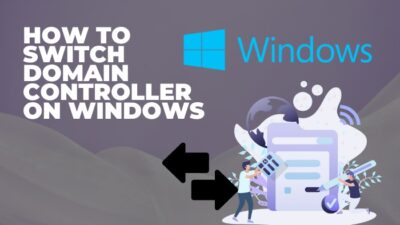Handheld gaming has never seen the craze and competition as it’s going on right now. The release of the Steam Deck has sparked a debate about whether it’s better than the Nintendo Switch.
As the two devices are priced closely to one another, which one is better as a portable gaming system? This is what we’re about to find out in this article.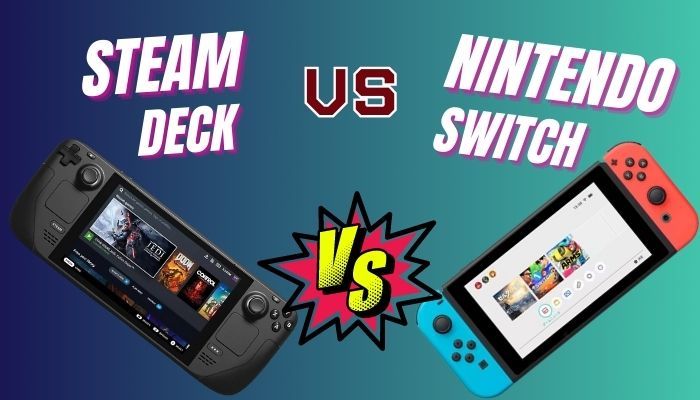
So, without further ado, let’s dive in.
Handheld Comparison: Steam Deck Vs. Nintendo Switch
Steam Deck is Valve’s first attempt to make a handheld PC gaming console, which is a dream come true for every gamer. Housing a custom AMD APU, along with unprecedented ergonomics, this device made a solid debut on February 25th, 2022. A worthy contender in the portable gaming space.
Nintendo Switch, on the other hand, came out back in 2017. It also has two more variants — a more expensive OLED and a cheaper Lite version. But they all have the same Nvidia chip under the hood.
Here is a detailed comparison between Steam deck and Nintendo Switch:
Steam Deck vs Nintendo Switch: Technical Specifications
| Steam Deck | Nintendo Switch | |
|---|---|---|
| SoC | AMD Zen 2 based custom APU (Van Gogh) | Custom Nvidia Tegra X1, X1+ (from August 2019) |
| CPU | AMD Zen 2 4cores, 8threads @2.4-3.5Ghz (448 GFlops FP32) | ARM Cortex A57, 4 cores, 4 threads, @1.02Ghz |
| GPU | Based on AMD RDNA 2, 8 compute units, @1-16Ghz Clock | Based on Nvidia Maxwell architecture, 256 Cuda cores, @307-768Mhz |
| System Memory (RAM) | 16GB LPDDR5, 5500MT/s | 4GB LPDDR4, 1600MT/s |
| Screen | 7-inch IPS LCD Touchscreen, 1280x800p, 16:10 aspect ratio | 6.2 inch LCD (Switch original), 7 inch OLED (Switch OLED), 5.5 inch (Switch Lite), 1280x720p, 16:9 aspect ratio |
| Brightness | 400nits | 318 nits (2019 and later models), 400 (OLED), |
| Refresh Rate | 60Hz | 60Hz |
| Output Resolution | 1080p @240Hz, 1440p @120Hz and 4K @60Hz | Up to 1080p @60Hz |
| Audio | Stereo speakers with embedded DSP, Dual Microphone array, 3.5mm headphone jack | Stereo speakers, 3.5mm port |
| Storage | 64GB eMMC/256, 512GB NVMe SSD | 32GB(Original) to 64GB (OLED) |
| Battery | 40Whr, 2-8 hours gameplay | 16Whr, 4.5-9 hours |
| Connectivity | Wi-Fi 5, Bluetooth 5.0 | Wi-Fi 5, Bluetooth 4.1 |
| Dimension | 11.7 x 4.6 x 1.8 inch | 9.4 x 4 x 0.55 inch (standard & OLED), 8.2 x 3.6 x 0.55 inch (Lite) |
| Weight | 669 grams (1.47lbs) | 400g (Original), 420g (OLED), 276g (Lite) with joy-cons attached |
Design & Build Quality
Looking at the Steam Deck and Nintendo Switch, the design on both of the unit pronounce them as a gaming device out and out. But the Steam Deck looks and feels more sleek, thanks to the all-black color. D-pad, thumbsticks, ABXY, and other buttons are arranged around the screen. That is true on both of the handhelds.
Each of the consoles is well-built. The Steam Deck, however, feels more sturdy than Switch. This is because Deck has no detachable joycon baked into it, unlike the Switch.
Nintendo Switch, on the other hand, is a bit flimsy where the Joycons connect to the console. It is workable and not a dealbreaker by any means.
Size
Dimensionally, things drift apart quite a bit. Steam deck is bigger compared to the Switch. It is even larger for a handheld gaming device. Lengthwise, Nintendo Switch stops at 9.4 inches, whereas Valve’s console stretches to 11.7 inches.
Weight
The extra real estate of the Steam Deck also adds significant bulk, weighing 669 grams. The heaviest Nintendo Switch (OLED), on the flip side, comes at 420 grams. Not to mention, the regular Switch and Switch Lite are even lighter and weigh 400g and 276g, respectively.
Display
The screens on Steam Deck and Nintendo Switch regular version are 7 and 6.2 inches IPS LCD panels, respectively. While Valve’s Deck boasts 400 nits peak brightness, Switch sets the ceiling at around 340 nits.
They produce similar image quality and have almost identical display resolutions— 1280x800p and 1280x720p, respectively. Steam Deck, however, has a 16:10 aspect ratio, turning away from Switch’s 16:9.
Speaking of display quality, Nintendo Switch OLED sweeps the floor by a mile. It has, as the name suggests, a brighter, more vibrant, high-contrast OLED panel, which produces color depth in images and deep blacks. However, this panel does not support HDR.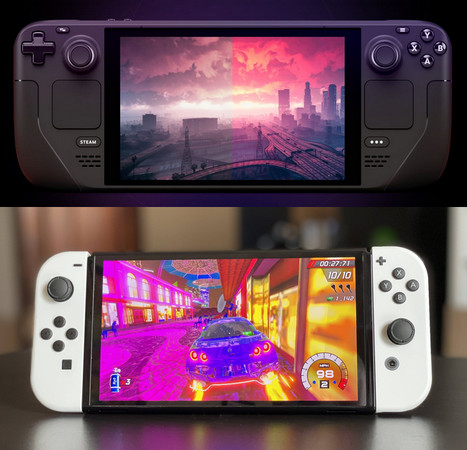
This display also has narrow bezels all around. That makes it an eye candy in every way possible.
If I draw a conclusion, Nintendo Switch OLED is the clear winner when it comes to the display department. But that doesn’t make the Steam Deck’s screen bad at all. In its own right, it’s more than a usable display.
Performance
Valve’s Steam Deck is a significantly more powerful and capable device than the Nintendo Switch. It’s in a league of its own. There’s literally no competition.
Steam Deck sports a custom-made AMD Van Gogh APU, which has 4 Zen 2 CPU cores with hyperthreading. The maximum boost clock for this CPU is 3.5GHz.
This custom chip has an RDNA 2-based GPU that has 8 compute units. This entire package is capable of delivering 1.6 TFLOPS of performance. It’s like XBOX One or PS4 in your palm.
Nintendo Switch, on the other hand, has a custom Nvidia Tegra X1 chip, which was updated to a highly binned Tegra X1+ chip in August 2019. This SoC has 256 Maxwell CUDA cores. To put into perspective, this chipset is weaker than most high-end modern smartphone SoC.
The Steam deck can play almost any PC game at a respectable frame rate. Obviously, graphics settings need to be dialed down in modern games such as Cyberpunk 2077 because it’s still a handheld gaming device.
Supersampling & Upscaling
However, AMD’s supersampling technology FSR can boost the performance of the Deck even further. And if the latest iteration of this technology, FSR 3.0 makes it to the Steam Deck, it may see a 2x frame rate boost.
Here’s a quick look at how well Steam Deck performs in modern PC games: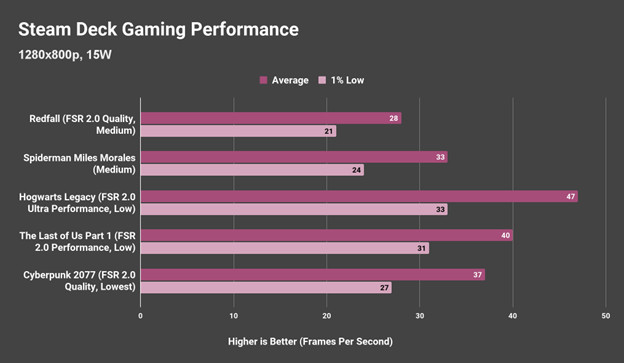
Coming back to the Switch, it runs multi-platform games at a much lower resolution, barely producing 30 frames per second. Not to mention, the graphics quality is lowered aggressively.
That said, Switch can play first-party games flawlessly at 60 FPS despite having hardware limitations. Mario Odyssey, Splatoon 3, Mario Kart 8, and The Legend of Zelda: Link’s Awakening, to name a few.
Besides, graphically intensive and nicer-looking games like the Legend of Zelda Breath of the Wild and Tears of the Kingdom run at 30fps. It’s amazing even to think how Nintendo optimizes games for almost a decade-old chip.
Battery Life
The Nintendo Switch is far superior in terms of battery life. Its lackluster Tegra X1/X1+ Nvidia chip consumes less power and can play games for 5-9 hours. At least, this is what I’ve experienced. For a handheld gaming console this size, a mind-blowing battery backup.
Steam Deck falls on its face every in terms of battery life. The custom AMD Zen 2 based chip powered by RDNA 2 graphics requires more juice to operate. I can have 1.30-2 hours of gameplay time when it comes to demanding PC games. But for easy-to-run indie and 2D games, this handheld can last up to 4 to 6 hours.
So, across the board, the Switch takes the crown for battery life.
Audio
Steam Deck’s speakers are much better than the Nintendo Switch. Even the upgraded speakers of the Switch OLED can’t stand a chance.
Speakers of the Steam Deck output are way louder, clearer, richer bass, and overall higher-quality sound provider. Music and sound effects come to life during the gameplay on Valve’s handheld.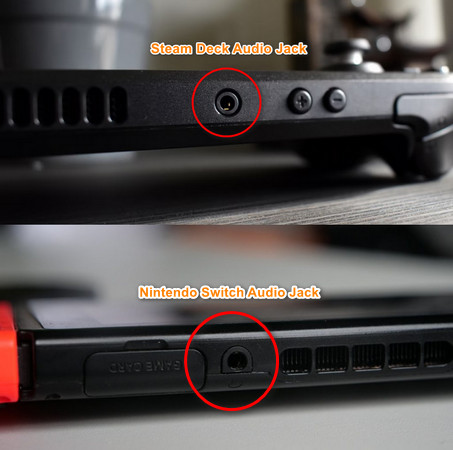
Both, however, include a 3.5mm headphone jack on the unit to use wired headphones for low latency and a rich audio experience.
Controls & Ergonomics
Controls and ergonomics are designed to perfection on Steam Deck. Valve has taken advantage of its handheld’s larger footprint and bulky size. The Deck fits in the hand perfectly when picked up.
The grip is amazing. It makes anyone forget they are holding an object that mulls over a pound. Besides, taller thumbsticks and the full-blown D-pad produce comfort. Apart from that, it also houses the regular ABXY face buttons, clicky shoulder, and 4 additional programable buttons.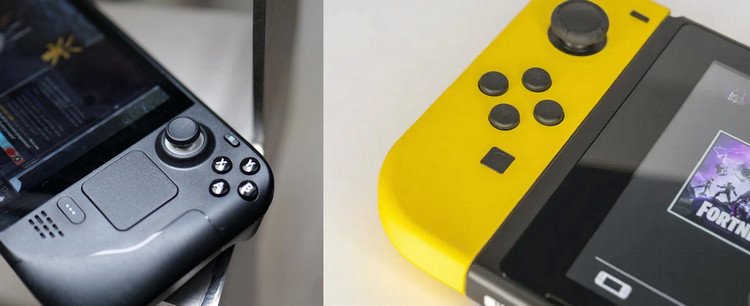
Moreover, two trackpads to imitate a mouse-like control is a thoughtful implementation. These are useful for point-and-shoot games or PC games.
Having said that, Nintendo Switch’s Joy-Cons are detachable. This is a clever approach to make the console more portable. But the thumbsticks are tiny and prone to drift. The shoulder buttons are smaller as well.
In terms of grip, the Nintendo Switch is outright awful. Hands stay flat around the back. And after a while, they get sore.
Games Library
Steam Deck has access to thousands of games out of the box. Thanks to Steam Library. So, technically, it is possible to play any PC game out there.
Not every game, however, runs super smooth. That is why Valve specifies which game will run on Steam Deck without a problem and provide optimal experience.
Gaming experience depends on the capability of the handheld and optimization. Steam Deck can run Cyberpunk 2077, and Elden Ring at 30 fps on the lowest settings, for example. In comparison, Call of Duty Black Ops runs at 60fps at the highest graphics settings.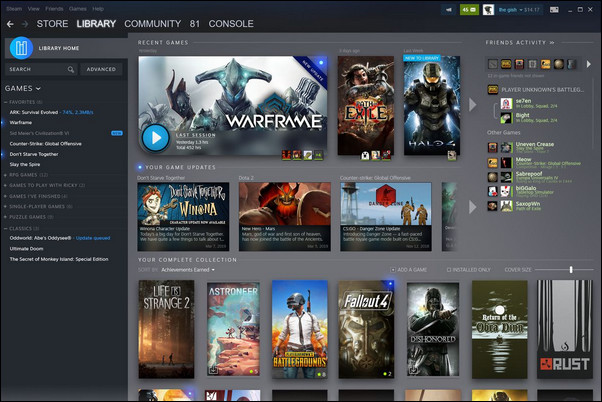
On the other side of the spectrum, Nintendo Switch also has a rich Game Library. Though, it’s a far cry from the number of games available on the Steam Deck.
Nintendo has its own exclusives, like Mario, Zelda, Pokemon, etc., made for the Switch console. Also, some multi-platform games like The Witcher 3: Wild Hunt, FIFA, and others are available for this handheld.
But with legendary first-party titles like The Legend of Zelda: Breath of the Wild, Tears of the Kingdom, and Xenoblade Chronicles, Nintendo Switch set itself apart from the Steam Deck in a good way. Besides, the retro Nintendo game library is getting updated regularly with more games.
But you know what’s more exciting?
Being a full-fledged handheld PC, Steam Deck can play some Nintendo Wii U, NES, Switch, PlayStation 2/3, PSP, and Xbox 360 exclusive games via emulators.
That’s not it!
It’s also a retrogaming beast that flawlessly emulates Neo-Geo, SEGA Genesis, and other arcade games. This puts Steam Deck ahead of Nintendo Switch.
Price & Availability
The regular Nintendo Switch, Switch OLED, and Switch Lite cost $300, 350, and $200, respectively. While the OLED model features 64GB of memory, the regular and lite variants of the console ship with only 32GB of internal storage.
Steam Deck at the same time starts at $400 with 64GB eMMC storage. It also has two variants with 256GB and 512GB NVMe storage. They cost $529 and $649 respectively.
Therefore, the Nintendo Switch is a cheaper and more budget-friendly gaming handheld. Both of the consoles are widely available.
Connecting To TV
The OLED and regular versions of the Switch include a dock in the box. It has an HDMI, a Displayport, a USB-C, three USB-A, and an Ethernet port.
When joycons from each end are removed, they both act as a standalone controller for the Switch. This elevates the multiplayer experience on the Nintendo handheld. It can output 1080p/60Hz to a TV or external monitor.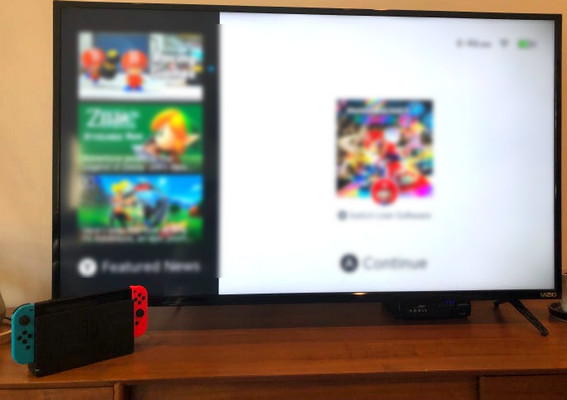
Moreover, games upscale more than the native 1280x720p resolution when Nintendo Switch is in dock mode. It uses a supersampling technology.
There’s no dock in the box for Steam Deck to connect to a TV or display. It will cost another $89 to purchase separately. Being a more powerful device, Steam Deck’s resolution can scale up to 4K at 60Hz, 1440p at 120Hz, and 1080p at 240Hz.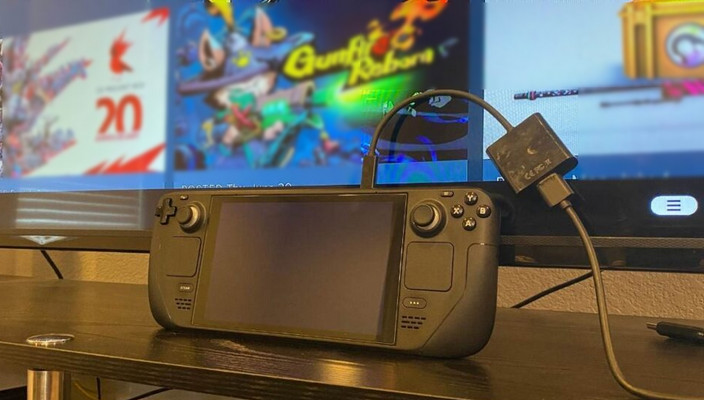
That said, with a USB-C to HDMI cable, it is possible to connect Deck to an external display or TV without a dock.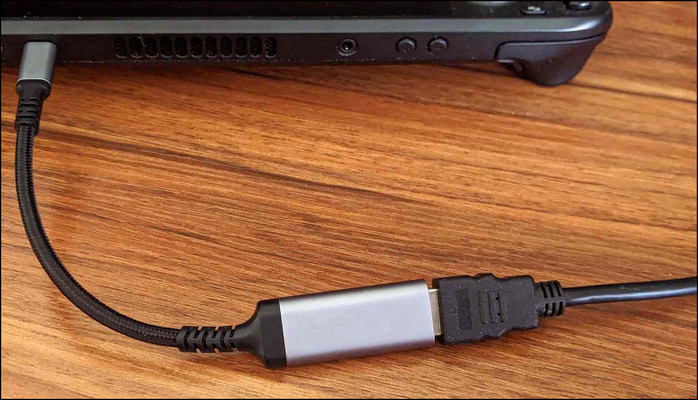
Cross-Platform Play
The Steam Deck and the Nintendo Switch both play cross-platform games. Minecraft, Fortnite, Roblox, Stumble Guys, Pokemon Unite, etc., are playable in online multiplayer mode regardless of the platform.
It makes the low-end gaming even more enjoyable. But in all these games, Steam Deck runs at a better frame rate due to its far superior hardware than the Nintendo Switch.
Portability
Nintendo Switch is more portable than the Steam Deck, mainly because of the size and weight difference. The ability to detach the Joycons from the console makes the Switch super pocketable.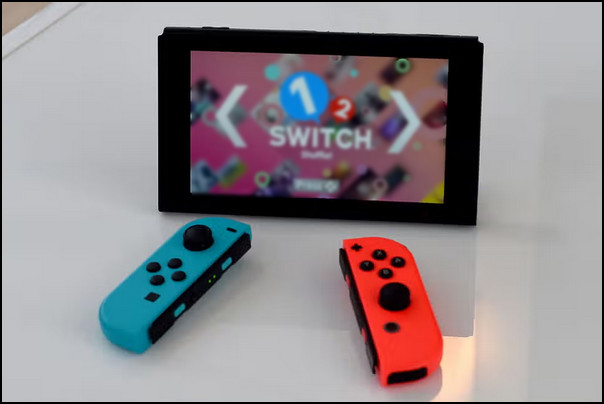
The extra length and bulk of the Steam Deck make it more difficult to carry around. However, it’s not entirely immobile. I could fit it in my backpack easily, along with a laptop and camera.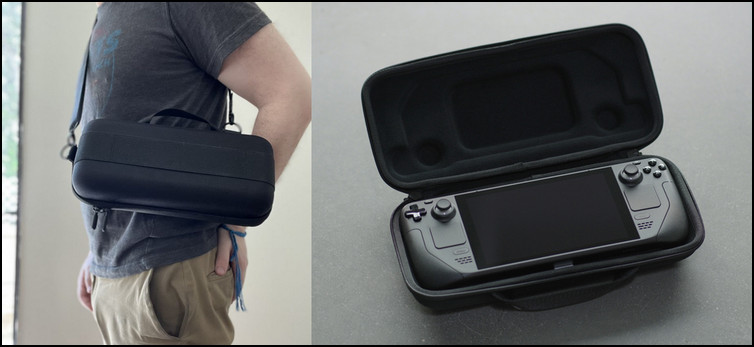
On an additional note, the Steam Deck is more versatile. It’s a gaming handheld on the go and a full-blown desktop computer when docked.
Steam Deck vs Nintendo Switch: Which Gaming Handheld is Better?
Steam Deck is clearly better in terms of hardware, game library, and controls. But Nintendo has perks like exclusive games, great battery life, and cheap prices. As the two competing handhelds are different platforms, it’s a personal preference. Overall, the Steam Deck is a better gaming handheld.
With that being said, it’s not like the Switch is a terrible handheld. It never is. The price it comes at is enough to make it to the top of the shopping list of any gamer.
Here’s a quick look at the pros and cons of Steam Deck and Nintendo Switch:
Steam Deck
- »More capable and powerful gaming handheld than Switch.
- »Excellent ergonomics, better controls with well-thought-out buttons and touchpad layout.
- »Far superior game library than Switch.
- »Poor battery life compared to Switch.
- »Bulky and large for a handheld.
Nintendo Switch
- »Outstanding battery life.
- »Super portable handheld gaming system.
- »Nintendo exclusives provide an amazing gaming experience..
- »Weak and outdated hardware.
- »Ergonomics are not as good as the Steam Deck.
FAQs
Can a Steam Deck Replace Nintendo Switch?
Steam Deck is not directly a Nintendo Switch replacement. Although both of the devices are handhelds, Switch has perks over the Steam Deck, such as first-party exclusive games, superior battery life, and portability.
Is Steam Deck More Powerful than a PC?
No, Steam Deck is not more powerful than a regular PC. However, computers with older hardware might fall behind the Steam Deck. But modern desktop PCs with average-tier CPU and GPU will always come ahead of the Steam Deck.
Is Steam Deck Better than PS5?
PS5 and the Steam Deck are completely different devices. While Steam Deck offers a gigantic game library, PS5 offers outstanding exclusives. Besides, PS5’s hardware puts Steam Deck to shame. But PS5 can never take the spot of the Steam Deck as a handheld gaming machine.
Conclusion
In many aspects, Steam Deck is obviously the better and more powerful handheld than the Nintendo Switch. A versatile device like the Deck is a better pick in the current market. But for anyone rooting for exclusive Nintendo games and a more portable option, Nintendo Switch is a no-brainer.

